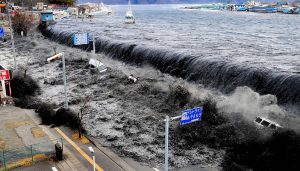
The devastating 2011 earthquake, tsunami, and resulting nuclear disaster in Japan had a high mental health impact — with some effects persisting several years later, according to a comprehensive research review in the January/February issue of the Harvard Review of Psychiatry, published by Wolters Kluwer.
Although symptoms of posttraumatic stress disorder (PTSD) related to the Great East Japan Earthquake seem to have improved over time, there is evidence of persistent problems with depression, reports the study by Dr. Shuntaro Ando of Tokyo Metropolitan Institute of Medical Science and colleagues. Their findings highlight specific areas and groups of disaster victims who may have a special need for long-term mental healthy support.
Evidence Shows Mental Health Impact of ‘Triple Disaster’
On March 11, 2011, a magnitude 9.0 earthquake occurred off the Pacific Coast of northeastern Japan. A resulting tsunami damaged the Fukushima-Daiichi Nuclear Power Plant, leading to a major nuclear disaster in addition to other local destruction. Four years after this unprecedented “triple disaster,” more than 80,000 people were still living in temporary housing.
To assess the mental health impact of the Great East Japan Earthquake, Dr. Ando and colleagues identified and analyzed 42 research papers reporting on the type, severity, and prevalence of mental health problems in areas affected by the disaster. The analysis included information on trends in mental health problems over time and risk factors for developing such problems.
In all studies that examined posttraumatic symptoms, the prevalence of PTSD was ten percent or higher. Depression and child behavior problems were also reported frequently — although estimates varied widely due to the use of differing measures and cutoff points.
In studies investigating trends in mental health problems over time, posttraumatic stress symptoms tended to improve, or in any case not to get worse. In contrast, depression symptoms tended to persist during follow-up.
Risk factors for mental health problems included resettlement of daily lives, pre-existing illness, and small social network size. The reported prevalence of post-traumatic stress reactions was higher in Fukushima prefecture, where the damaged nuclear power station was located.
Suicides increased initially, followed by a decrease in the two years after the earthquake. However, the suicide rate remained higher than the pre-disaster level in Fukushima, in contrast to neighboring prefectures.
Natural disasters are known to increase the risk of mental health problems, with the potential for long-term effects. Because of its magnitude and unique characteristics, the Great East Japan Earthquake might have an even greater mental health impact than previous disasters.
The results add to previous studies showing a high prevalence of PTSD and other mental health problems after this unique disaster. “The prevalence and severity of mental health problems seemed to be higher in Fukushima than in other prefectures, and some specific risk factors were reported for the region,” Dr. Ando and colleagues conclude. The results suggest the need for long-term mental health support in Fukushima — perhaps especially targeting evacuees who are still living in temporary housing.
Reference:
Shuntaro Ando, Hitoshi Kuwabara, Tsuyoshi Araki, Akiko Kanehara, Shintaro Tanaka, Ryo Morishima, Shinsuke Kondo, Kiyoto Kasai. Mental Health Problems in a Community After the Great East Japan Earthquake in 2011. Harvard Review of Psychiatry, 2017; 25 (1): 15 DOI: 10.1097/HRP.0000000000000124
Note: The above post is reprinted from materials provided by Wolters Kluwer Health.










